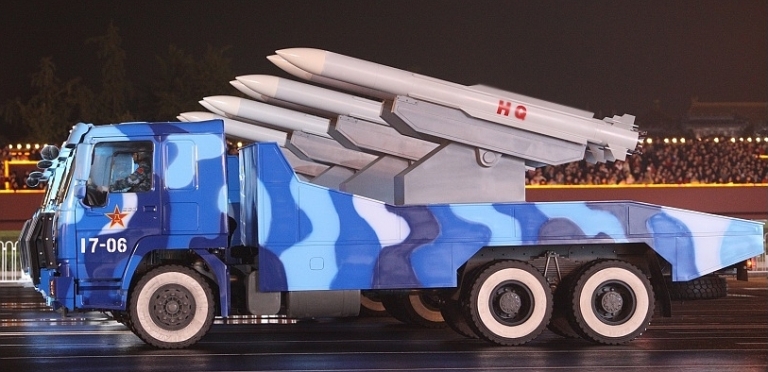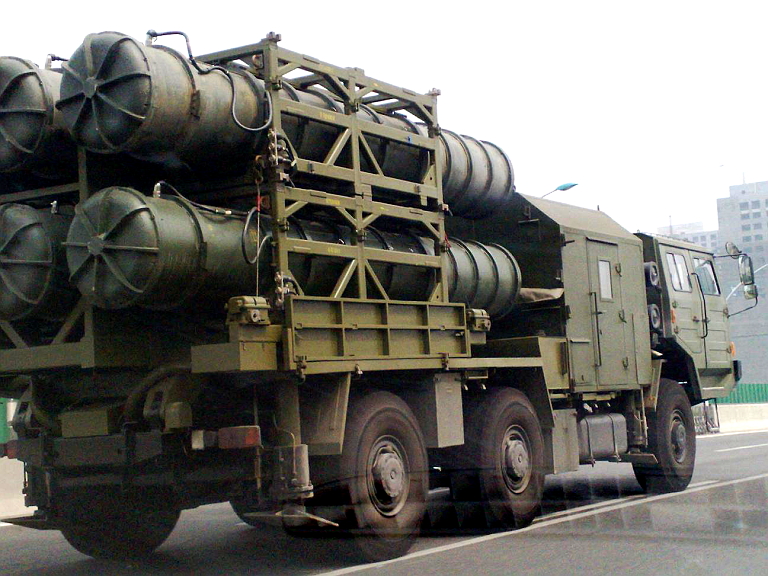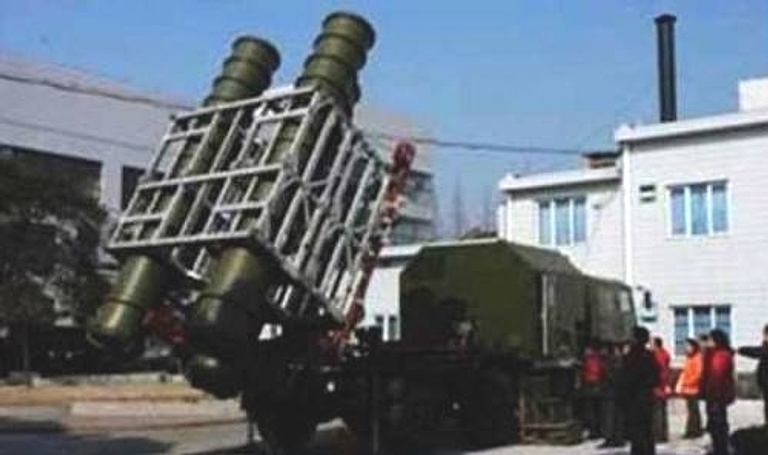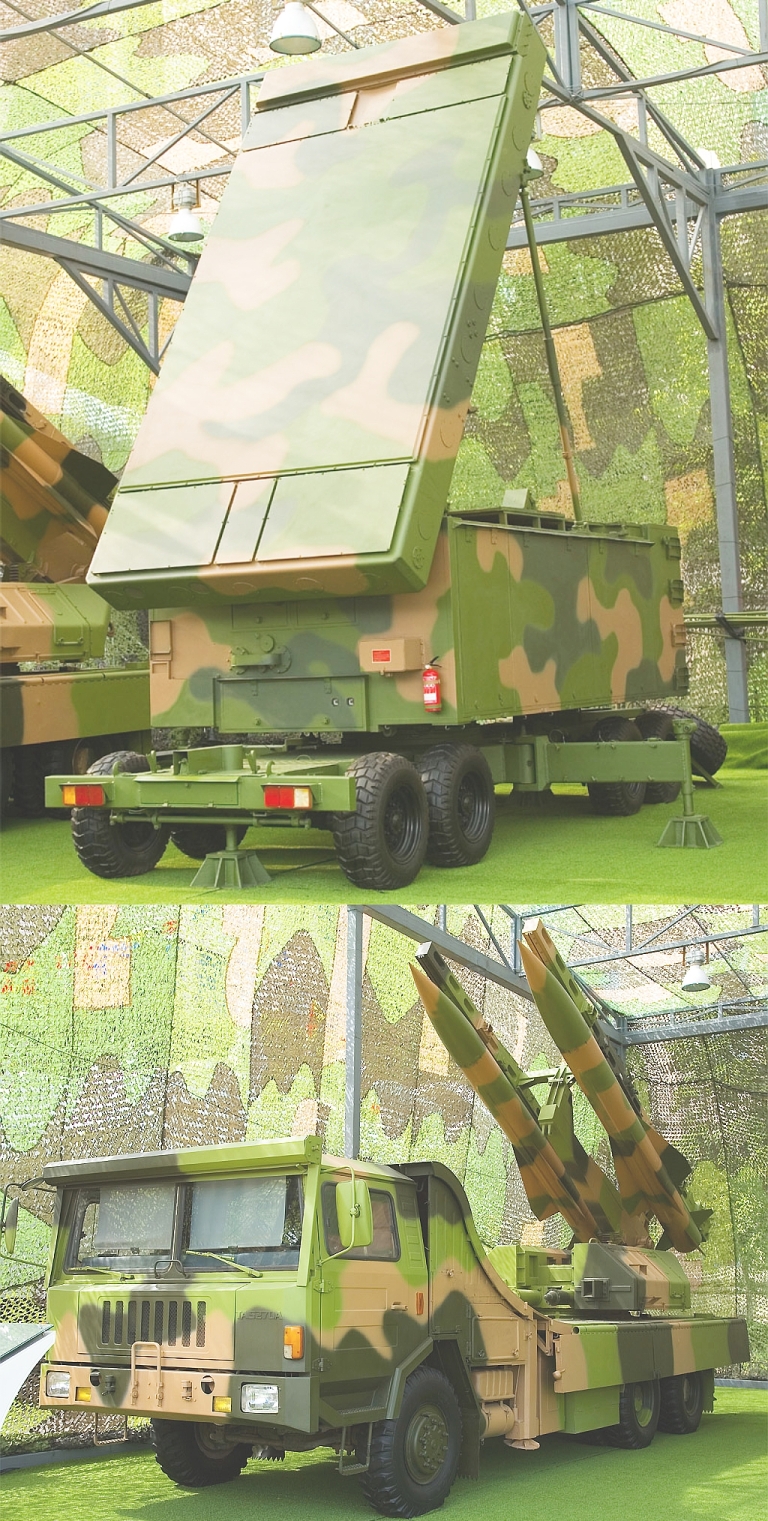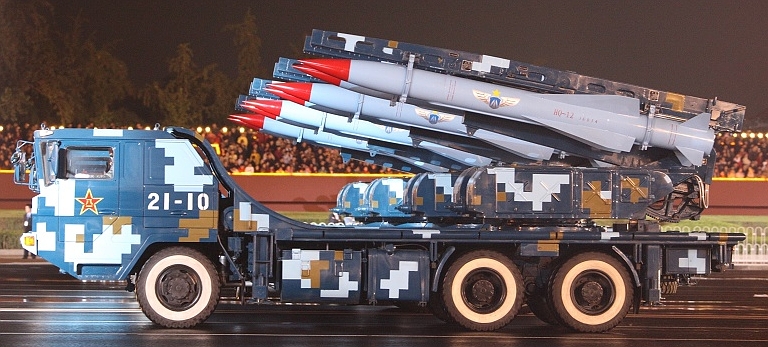|
||||||||||||||||||||||
![Home - Air Power Australia Website [Click for more ...]](APA/APA-Title-Main.png) |
||||||||||||||||||||||
![Sukhoi PAK-FA and Flanker Index Page [Click for more ...]](APA/flanker.png) |
![F-35 Joint Strike Fighter Index Page [Click for more ...]](APA/jsf.png) |
![Weapons Technology Index Page [Click for more ...]](APA/weps.png) |
![News and Media Related Material Index Page [Click for more ...]](APA/media.png) |
|||||||||||||||||||
![Surface to Air Missile Systems / Integrated Air Defence Systems Index Page [Click for more ...]](APA/sams-iads.png) |
![Ballistic Missiles and Missile Defence Page [Click for more ...]](APA/msls-bmd.png) |
![Air Power and National Military Strategy Index Page [Click for more ...]](APA/strategy.png) |
![Military Aviation Historical Topics Index Page [Click for more ...]](APA/history.png)
|
![Intelligence, Surveillance and Reconnaissance and Network Centric Warfare Index Page [Click for more ...]](APA/isr-ncw.png) |
![Information Warfare / Operations and Electronic Warfare Index Page [Click for more ...]](APA/iw.png) |
![Systems and Basic Technology Index Page [Click for more ...]](APA/technology.png) |
![Related Links Index Page [Click for more ...]](APA/links.png) |
|||||||||||||||
![Homepage of Australia's First Online Journal Covering Air Power Issues (ISSN 1832-2433) [Click for more ...]](APA/apa-analyses.png) |
||||||||||||||||||||||
| Last Updated: Mon Jan 27 11:18:09 UTC 2014 | ||||||||||||||||||||||
|
||||||||||||||||||||||
PLA Area Defence Missile Systems |
||||||||||||||||||||||||||||||||||||||||||||||||||||||||||||||||||||||||||||||
| by
Dr
Carlo
Kopp, AFAIAA,
SMIEEE,
PEng March/April 2009 Updated September, 2009 Updated November, 2009 Updated April, 2012 Text, Line Art © 2009 - 2012 Carlo Kopp |
||||||||||||||||||||||||||||||||||||||||||||||||||||||||||||||||||||||||||||||

|
||||||||||||||||||||||||||||||||||||||||||||||||||||||||||||||||||||||||||||||
IntroductionThe 2007/2008 period saw an
important incremental improvement in what is already a formidable air defence capability, as the PLA deployed four
battalions of
the S-300PMU-2 / SA-20 Gargoyle high mobility long range SAM system.
This is another step in China's long march since the end of the Cold War, to deploy a modern multi-layered Integrated Air Defence System (IADS). When the
Soviet
Union collapsed in 1991, China's air defence
capabilities were of debatable effectiveness, built around indigenous
clones of
the Soviet S-75 Dvina / SA-2 Guideline, and indigenous fighter aircraft
such as
the Chengdu J-8 Finback, in addition to vast numbers of 1950s and 1960s
technology J-6 Farmer and J-7 Fishbed
fighters. Radar
capabilities centred on cloned 1950s
Soviet
equipment, some pre-Tienamen Western
imports, and a
stalled indigenous AEW&C program centred
on a
turboprop engined Tu-4 Bull / B-29 Superfortress airframe.
Much has
changed over the following decade and a half. While the SA-2 remains
numerically significant, it has been modernised.
Patriot
class
S-300PMU
/
SA-10
/
SA-20
Grumble
/ Gargoyle long range SAMs
have been acquired in strategically
significant
numbers. The Tor M1 / SA-15 has been reported, and a range of
indigenous short to
medium range SAMs have been developed. The
KJ-200 /
Y-8 and KJ-2000 / A-50 AEW&C programs are well into advanced
development,
and strategically significant numbers of the Su-27SK / J-11 and Su-30MK
have
been deployed, while the indigenous “Sinocanard”
J-10
fighter
has
achieved
Initial
Operational
Capability.
The PLA's air defence capabilities are transforming from a legacy force with static and undeployable systems, to a state of the art force, which is highly deployable in country, and demonstrably expeditionary as it matures. This evolution in capabilities has been sufficient to elicit alarm in many US analysts, recognising that legacy fighters such as the F-15C/E and F/A-18C-F have very poor odds of surviving if they need to penetrate the emerging PLA IADS. Following past practice, China is aggressively marketing their current SAMs in the export market, these including the HQ-9 and HQ-12. There are speculative reports that Iran is to procure the HQ-9, following reports that numerous HQ-2 batteries were procured. |
||||||||||||||||||||||||||||||||||||||||||||||||||||||||||||||||||||||||||||||
Indigenous and Derivative Missile Systems |
||||||||||||||||||||||||||||||||||||||||||||||||||||||||||||||||||||||||||||||
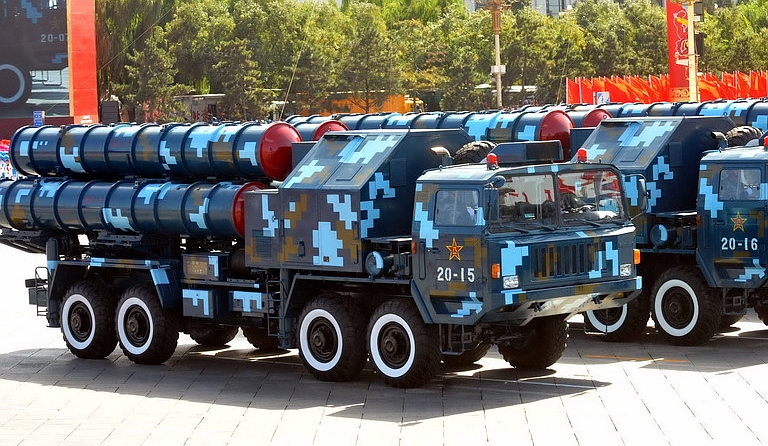 HQ-9 TEL using the Taian TAS-5380 chassis. Additional image [1] (via Chinese Internet). The
FD-2000/HQ-9 was
developed to provide a long range SAM capability, distinct from the
medium
range capabilities of the HQ-12/KS-1 series. The FT-2000 is a derivative which is fitted with an anti-radiation
seeker and
intended for engagements against AEW&C/AWACS and stand-off jamming
aircraft. The US DoD puts current
deployments at 64
launchers, making for 8 to 16 batteries.
The PLA have
not been overly generous in disclosing details of this design. There is
general
agreement in open sources that the HQ-9 uses Russian S-300PMU
technology
extensively, including the cold launch design for vertical ejection
from
launcher tubes on TELs, 5V55/48N6 rocket
motor
technology, and a range of other S-300PMU components, including an 8 x
8 four
tube TEL modelled on the 5P85SU/DU series.
Some
sources claim the weapon uses a two stage
arrangement
akin to the S-300V, imagery shows these claims to be incorrect. Slant
range performance figures also vary across sources,
between 50
and 100 nautical miles. What data is available suggests a missile which
is
similar in capability to early variants of the MIM-104 Patriot and
SA-10B
48N6E, including Track via Missile (TVM) guidance.
The HQ-9 is
supported by the HT-233 phased array engagement radar, like the H-200 modelled on the MPQ-53 and 30N6E designs,
carried on an Taian
TAS5380 8 x 8 high mobility
vehicle, or common to the
HQ-9 TEL
and similar in design to the S-400's BAZ-6900 series vehicle.
Chinese sources claim C-band operation with 300 MHz receiver/antenna
bandwidth,
detection range of 65 nautical miles, and monopulse
angle tracking to resist jamming. Recently disclosed imagery shows the
use of the self-propelled YLC-2V as the
battery acquisition radar component. The designation FD-2000 is
for export configurations of the HQ-9.
Recent reports claim the missile combines midcourse inertial / datalink and terminal active radar homing guidance. Cited battery composition is one variant of the YLC-2V acquisition radar, one HT-233 engagement radar, 8 x Taian TAS-5380 TELs, with 32 ready rounds, one vehicle for battery positioning, one generator vehicle, one support vehicle and a mobile command post. A HQ-9 brigade level formation comprises six batteries[3]. The HHQ-9 is the navalised variant of the HQ-9, launched from a VLS system, on the Type 052B/C Luhai II class DDG. According the
US DoD, the FT-2000 has yet to be
deployed, as is the
case with the follow-on HQ-9 variants. Open sources describe the FT2000
as an inertially guided SAM with an
anti-radiation terminal
seeker, programmed before launch for the characteristics of the
intended
target. Cited frequency coverage is 2-18 GHz. Each battery includes
four ESM vehicles, used to generate
targeting
data for the missile battery. Intended targets including support
jamming aircraft, aircraft equipped with self-protection jammers, and
other radiating airborne targets, e.g. AWACS/AEW&C.
Given that
the
FT-2000 is derived from the HQ-9, claims that this weapon has not been
deployed
should be treated with caution, since the missile and its guidance
support
package could have been integrated into the baseline HQ-9 system
design, and
other than by covert intelligence gathering or PLA disclosure, this
cannot be
easily determined by simple observation. It is entirely conceivable
that a HQ-9
battery could be armed with a mix of HQ-9 /FD-2000 and FT-2000 rounds,
and this
could
only be determined in combat once missiles are actually launched and
enter
their terminal guidance phase.
FT-2000 Anti-Radiation SAM 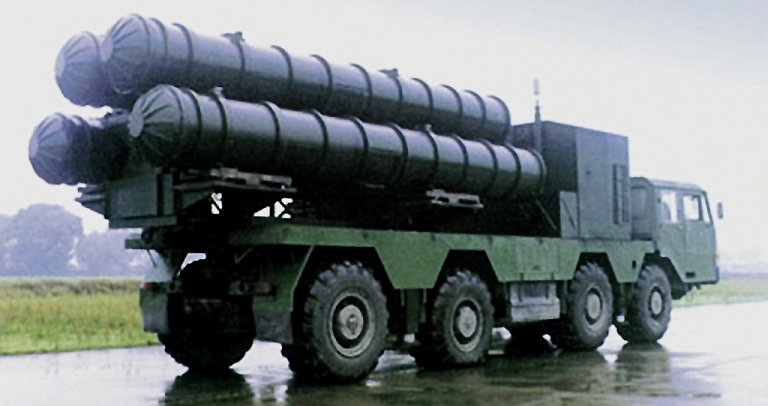 FT-2000 TEL on a variant of the 8 x 8
Taian
TAS-5380 chassis. Note the telescoping datalink antenna, absent on the
HQ-9 TEL design. The
hydraulic elevating launcher structural frame appears identical to the
HQ-9 TEL design (CPMIEC brochure image).
HQ-9/FD-2000 SAM 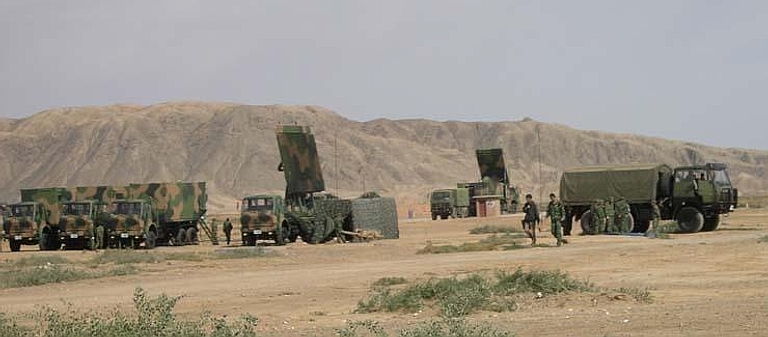 Deployed HQ-9 battery. Above, self
propelled YLC-2V to
the left with its
three support vehicles, in the background a HT-233 battery engagement
radar. Below, transloader in the foreground, HT-233 to the right. The
transloader is based on the same variant of the 8 x 8 Taian
TAS-5380 chassis (via Chinese
Internet).
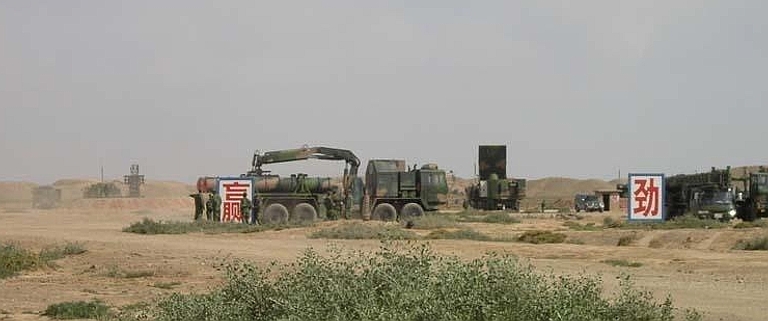 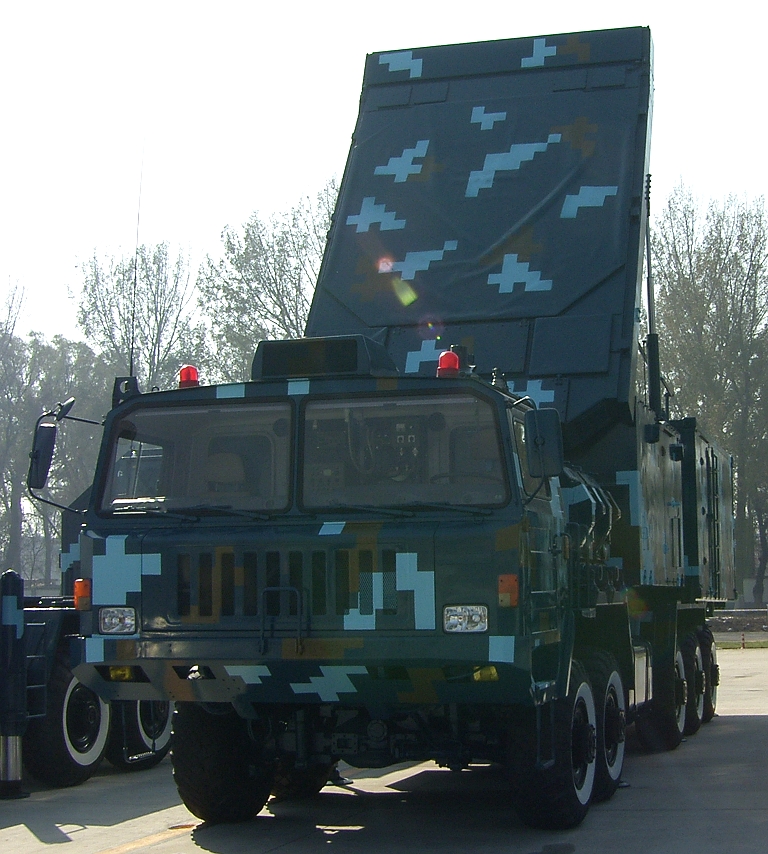
Production HT-233
PESA engagement radar on the 10 x 10 Taian TAS-5380 series chassis (©
2009, Bradley Huang).
HHQ-9 Naval SAM 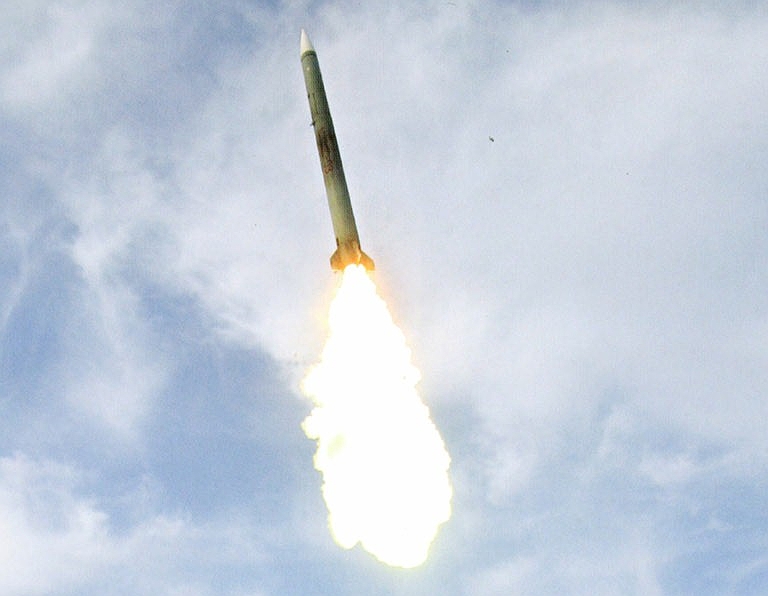 HHQ-9 launch at motor
ignition. The missile airframe closely resembles the 5V55/48N6 series
(via Chinese Internet).
|
||||||||||||||||||||||||||||||||||||||||||||||||||||||||||||||||||||||||||||||
CPMIEC
HQ-16 / SA-11 Gadfly
|
||||||||||||||||||||||||||||||||||||||||||||||||||||||||||||||||||||||||||||||
CNPIPC / CEIEC
/ CASIC KS-1A Kai Shan 1 / HQ-12
|
||||||||||||||||||||||||||||||||||||||||||||||||||||||||||||||||||||||||||||||
| KS-1A
Battery
Composition |
|
| 24
Missiles |
|
| 1
Guidance
radar
station |
|
| 6
Dual-rail
launcher
vehicles |
|
| 6
Transloader
vehicles |
|
| 2
Power
supply
vehicles |
|
| 1
Frequency
conversion
power
distribution
vehicle |
|
| 1
Missile
test
vehicle |
|
| 3
Missile
transport
vehicles |
|
| 2
Tool
vehicles |
|
| 1
Power
supply
vehicle |
|
| 1
Set
of
technical
support
equipment |
|
| 1
Electronics
maintenance
vehicle |
|
| 2
Spare
parts
vehicles |
|
| 1
Missile
testing
&
metrology
vehicle |
|
| KS-1A Missile Performance Specifications |
|
| Target
RCS: |
2
m2 |
| Max.
target-flying
speed: |
750
m/s |
| Altitude: |
0.3
km
-
27
km |
| Min.
slant
range: |
7
km |
| Max.
slant
range: |
38
km
(Target
speed:
<
720m/s) |
| 42
km
(Target
speed:
<
420m/s) |
|
| 50
km
(Target
speed:
<
320m/s) |
|
| Kill
radius
of
the
warhead: |
> 50m |
| Single-shot
killing
probability: |
89
% |
| Guidance
mode: |
radio
command
guidance |
| Launch
mode: |
Under-rail
suspension |
| Time
for
deployment: |
30
min. |
| Time
for
withdrawal: |
20 min. |
| Missile
diameter: |
400
mm |
| Missile
length: |
5644 mm |
| Missile
weight: |
886 kg |
| Operating
environment |
|
| Height
of
the
site: |
0
-
3,000
m
AMSL |
| Ambient
temperature: |
-40°
to
+50°
C |
| Relative
humidity: |
<
93% |
| Surface
wind
speed: |
<
20m/s |
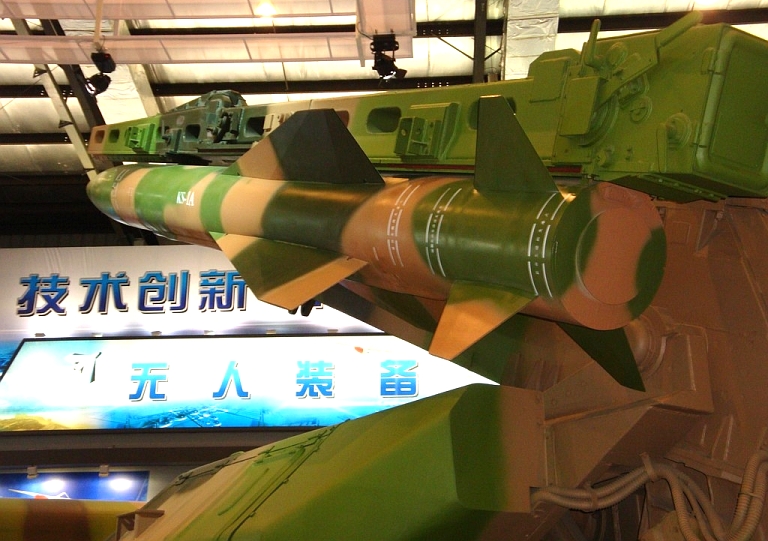
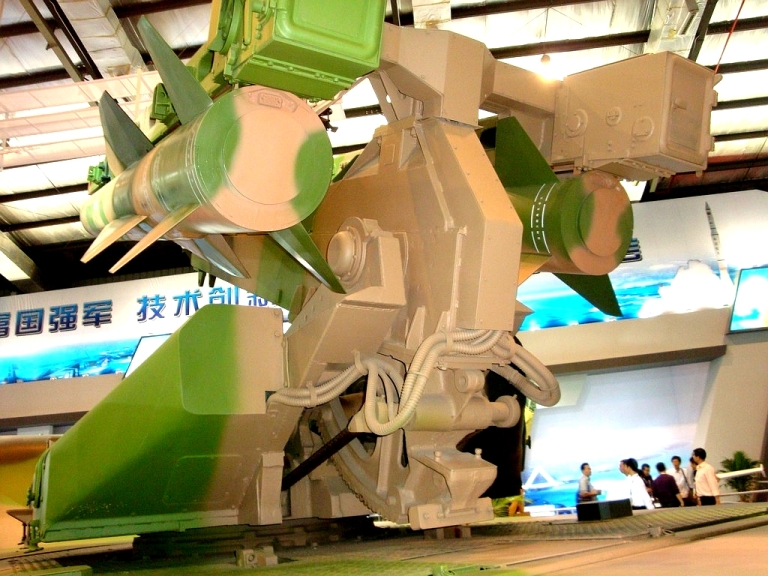
Detail of KS-1A launcher (image © 2009, Zhenguan Studio).
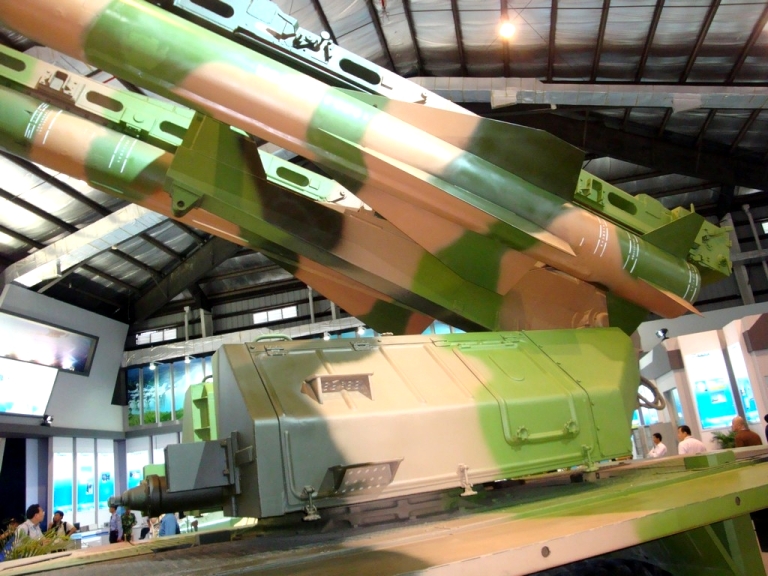
Detail of KS-1A launcher (image © 2009, Zhenguan Studio).
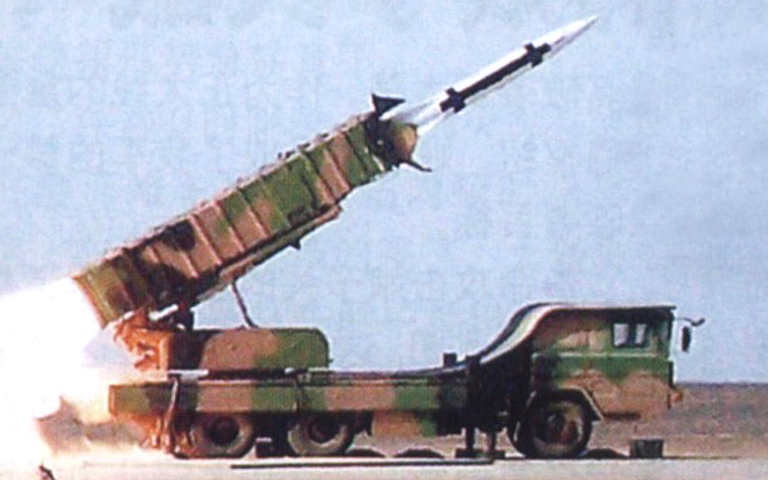
An alternate TEL arrangement uses elevating box launchers each containing one KS-1A round. The status of this variant has not been disclosed to date.
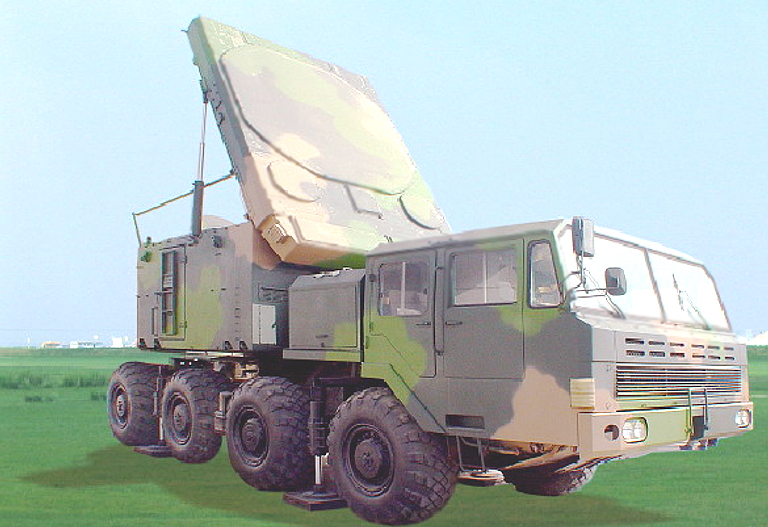
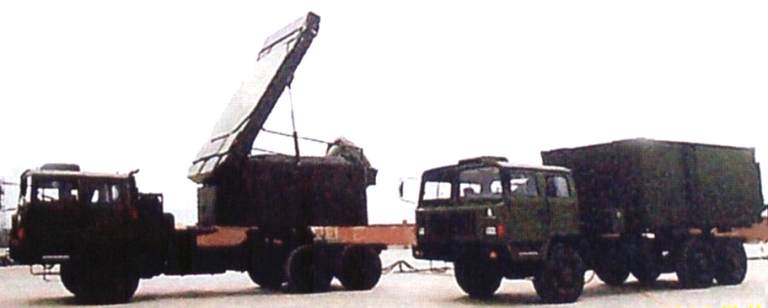
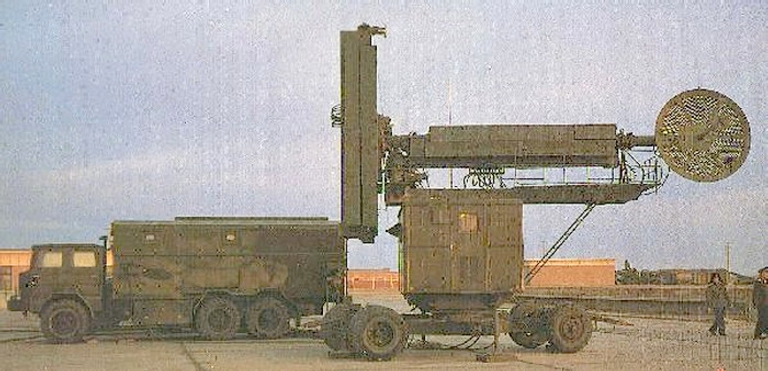
CPMIEC 2FA(B)/ ZD-2(B)/HQ-2BE / SNR-75A / HQ-2 and HQ2J Guideline[1]
WXZ204 HQ-2B Tracked Surface-to-Air Missile Launcher[2]
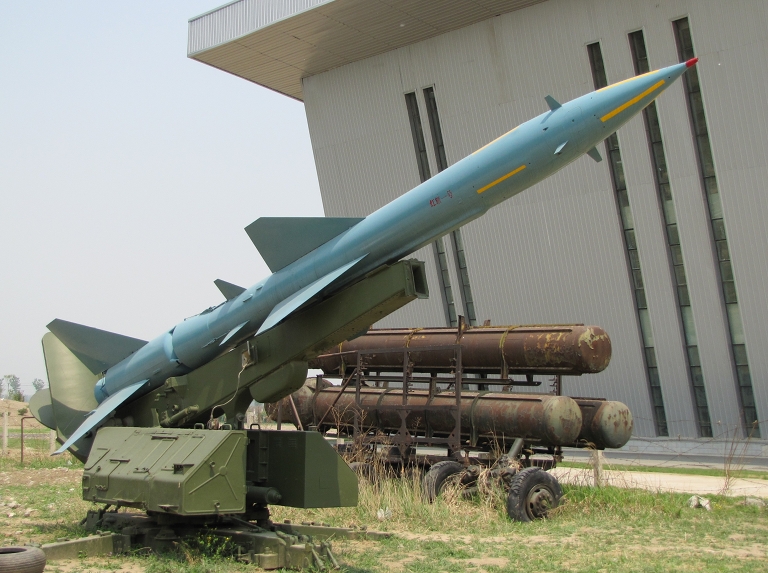
When the PRC split with the Soviets during the Krushchev era, early variants of the S-75 were the only then modern weapons China possessed, with a mere 6 batteries in service. These comprised the standard static road transportable semi-mobile rail launchers, the S-band Fan Song engagement radars, and the VHF band P-12 Spoon Rest acquisition radars. China's 5th Research Academy of the Ministry of Defence subsequently reverse engineered this hardware and started the manufacture of the HQ-1 (Hong Qi-1) , a cloned S-75 system. By 1966 an improved HQ-1, the HQ-2 was introduced, with incremental upgrades to the HQ-2A during the 1970s, and HQ-2B during the 1980s, the final variant being the HQ-2J.
Two engagement radars are associated with the HQ-2, both derivatives of the SNR-75 Fan Song series. These are the SJ-202 Gin Sling A and the 2FA(B) Gin Sling B.
Progressive design improvements included a better liquid rocket motor, more G capability, better warhead, digital command link for guidance with crypto capability, a monopulse engagement radar capability for jam resistant angle tracking, and electro-optical angle tracking.
The stated long term intent is to replace the HQ-2 with the indigenous HQ-12/KS-1A SAM, as a second tier supplement to the Russian S-300PMU series.
There is some evidence which suggests that hybridisation of legacy HQ-2 batteries with new generation H-200 PESA engagement radars may have occured. This remains to be validated by official disclosures or more detailed technical evidence.
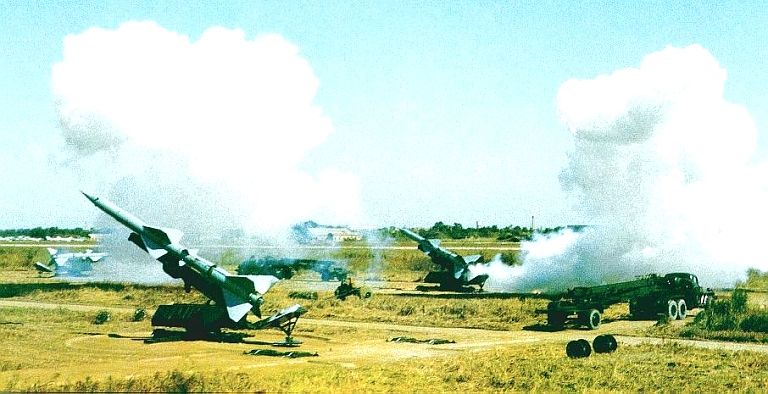
Above deployed HQ-2A battery, with the reverse engineered SM-90 launchers and PR-11AM transporter/transloader. Below a HQ-2A battery on display.
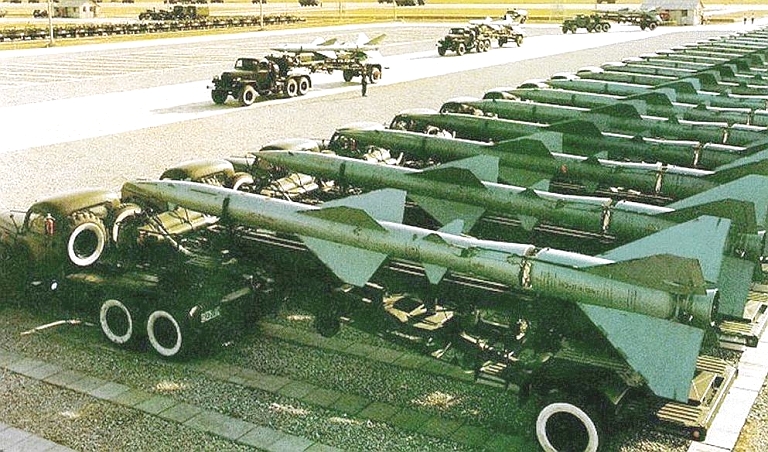
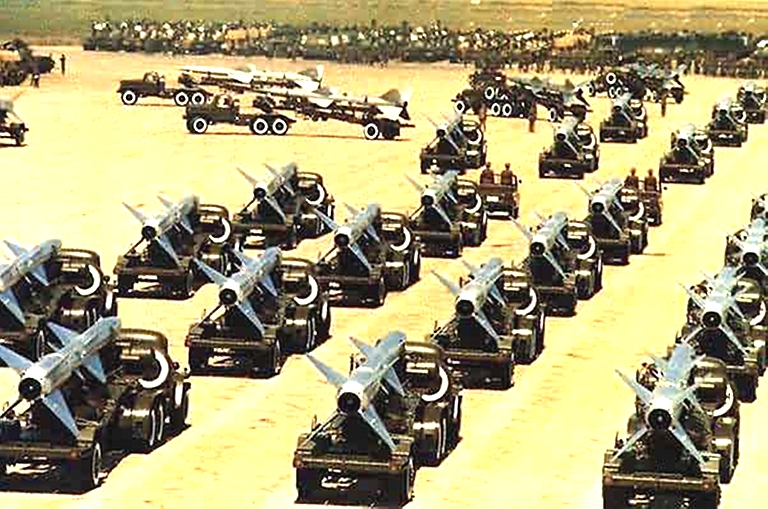
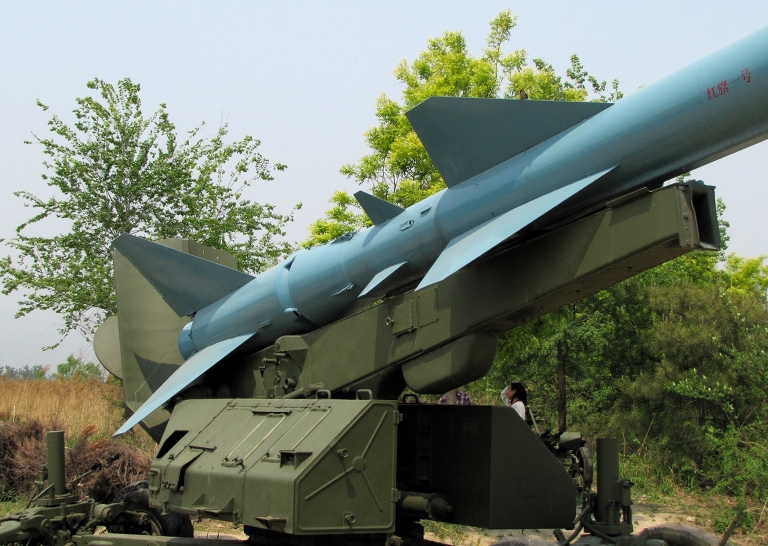
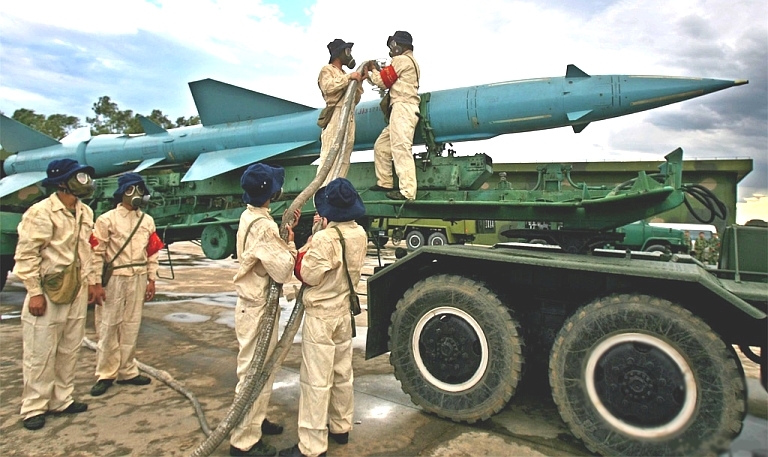
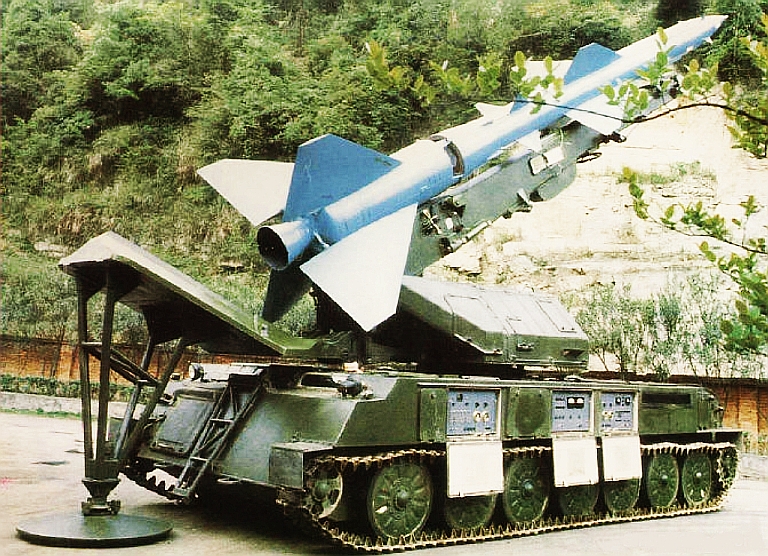
The
vehicle used a lengthened Type 63 amphibious tank chassis with an
additional
road wheel providing a total of
fourteen. With
the missile loaded it weighs 26 tonnes, with the missile weighing
approximately
2,200kg.[3] Two prototypes were built, but it does
not appear as yet to have entered production.
The
weapons system’s overall length when travelling was 13.235 m including
missile,
3.2m wide and 4.5m high. The hull
height was 1.57m. The diesel
engine produced 293 kW and a torque of 70.8 kN, and gave the vehicle a
maximum
road speed of 42.9 km/hr and a maximum road range of 250km. The low top speed and range suggest
that the engine was taxed moving the vehicle.
The
missile was mounted on its SM-90 derived static launcher, which was
modified
for fitting on the vehicle hull. It was able to traverse through 3600
, although it would normally be
fired
facing the vehicle front as the huge folding stabiliser at the rear of
the hull
acted as a flame and heat deflector. Two
large
cable
reels
contained
the
fire
control
cables
which
were attached to relevant air defence equipment. It
was not capable of firing at an
aircraft independently and a battery of these with its attendant
radars,
generators and control vehicles would occupy a considerable piece of
land.
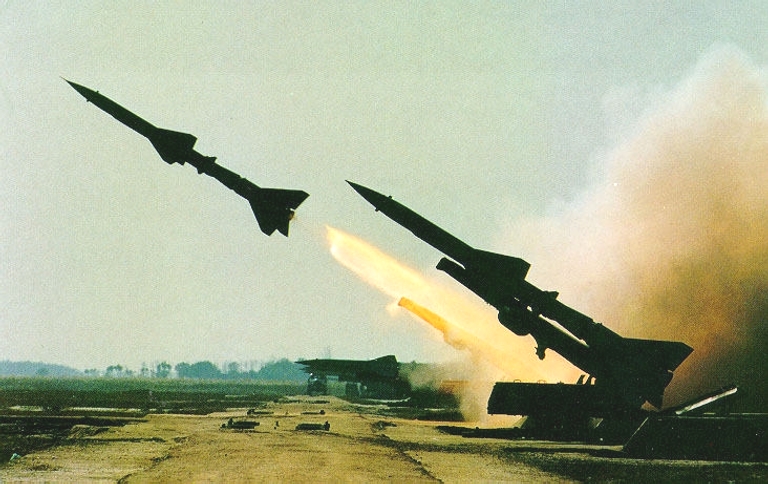
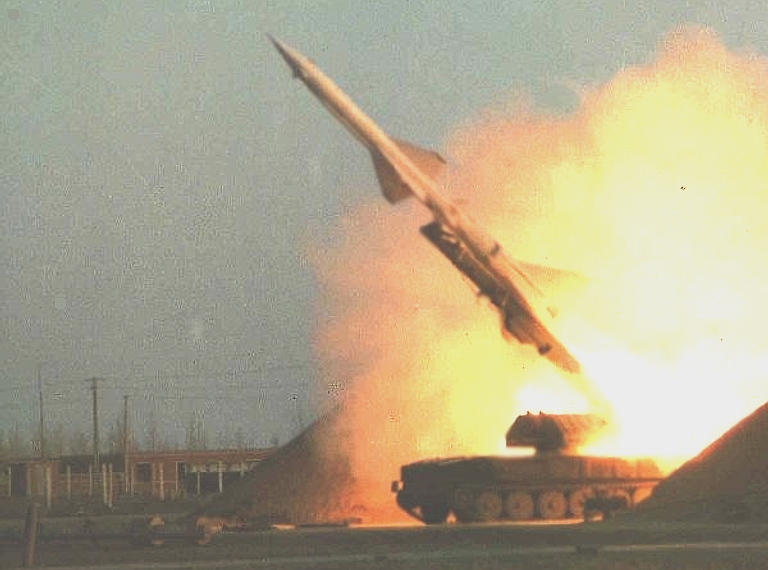
WXZ204 HQ-2B TEL.
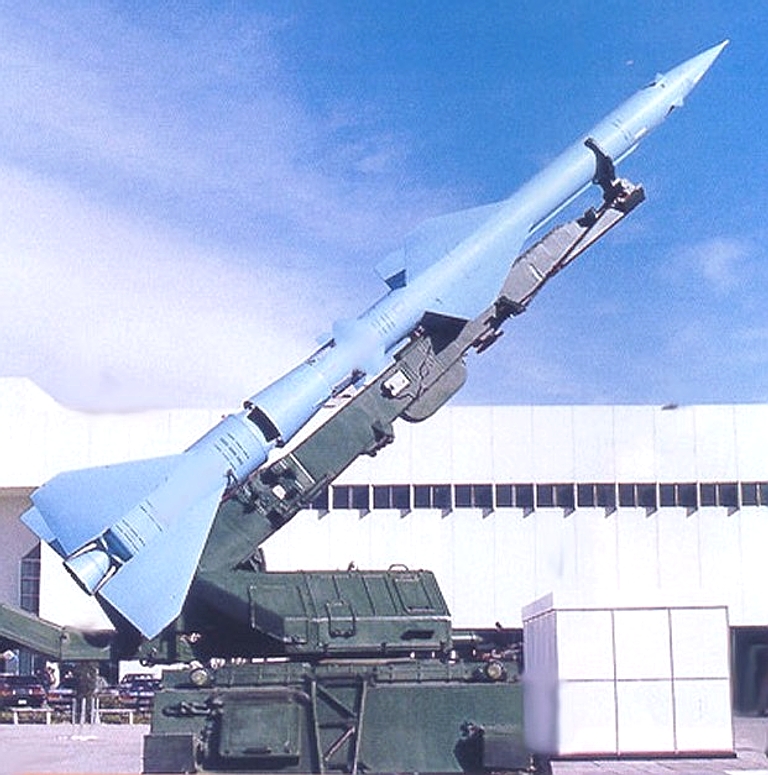
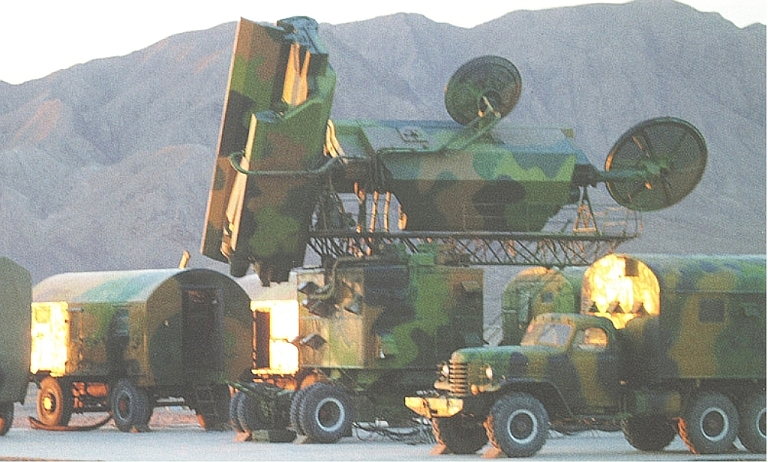

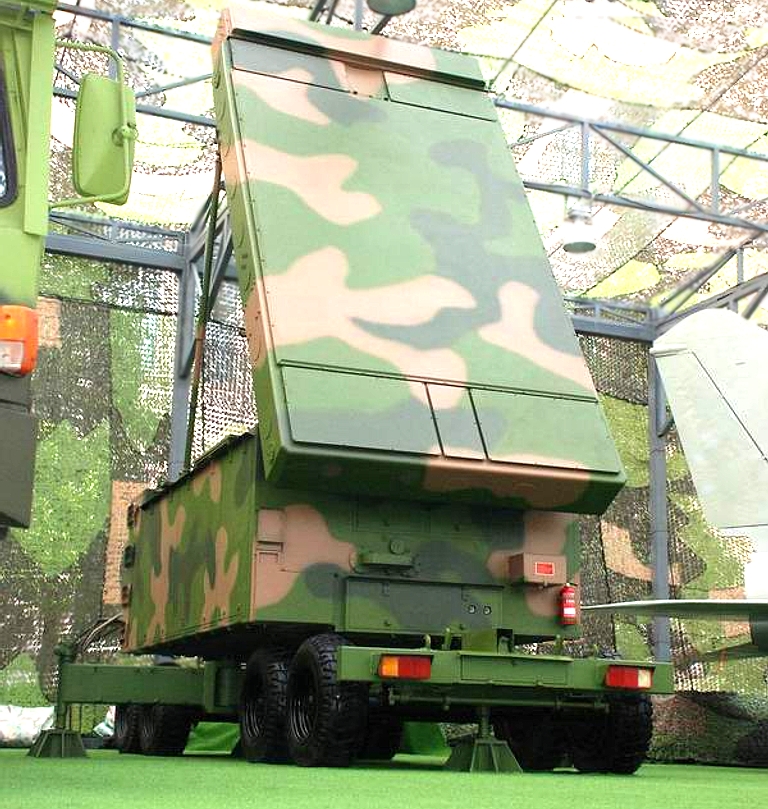
RWE-1 Missile Approach Warning System
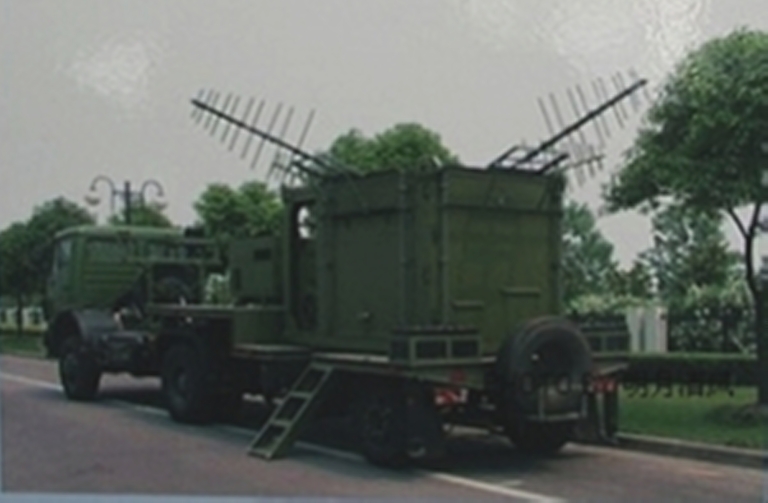
The RWE-1 is a radio-frequency band active MAWS intended to protect SAM batteries from attack by anti-radiation missiles such as the AGM-88 HARM/AARGM series. It is employed to trigger emitter shutdown and activation of active emitting decoys. The manufacturer's brochure claims a detection range of 40 km / 21.6 NMI.
DF capability is likely to be via amplitude comparison between channels, providing ~10° DF accuracy, adequate for cueing decoys, or cueing point defence weapons like the LD-2000 to acquire, track and engage the inbound missiles.
SAM System Index - [Click for more...]
SAM System Mobility - Air Defence System Vehicles [Click for more ...]
SAM System Integration - Air Defence Command Posts [Click for more ...]
SAM System Passive Targeting - Emitter Locating Systems [Click for more ...]
SAM System Counter VLO Capabilities [Click for more ...]
SAM System Proliferation - PLA Air Defence Missile Systems [Click for more ...]
SAM System Multimedia - Rosoboronexport Footage [Click for more ...]
Almaz-Antey S-300PMU-2 Favorit / SA-20B Gargoyle
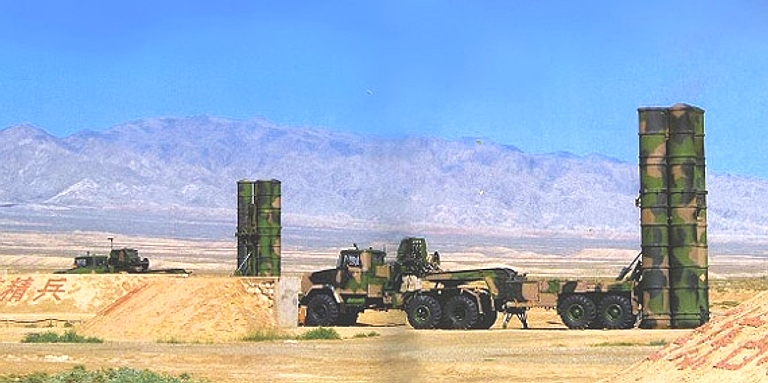
PLA 5P85TE TELs deployed in revetments.
The Favorit is an incrementally enhanced S-300PMU-1, encompassing the 30N6E2 Flap Lid, 64N6E2 Big Bird, 54K6E2 command post, and providing interfaces and software to control legacy missile batteries, such as the S-200VE/SA-5 Gammon. It is intended to compete directly against the Antey S-300V Giant and Patriot PAC-2/3 systems as an Anti-Ballistic Missile system. The new LEMZ 96L6E search radar is available as an option with the Favorit.
With the S-300PMU-1 and PMU-2 the PLA gains enough range to be able to threaten aircraft over Taiwan if the missile batteries are deployed along the coastline.
Almaz S-300PMU-1 / SA-20A Gargoyle
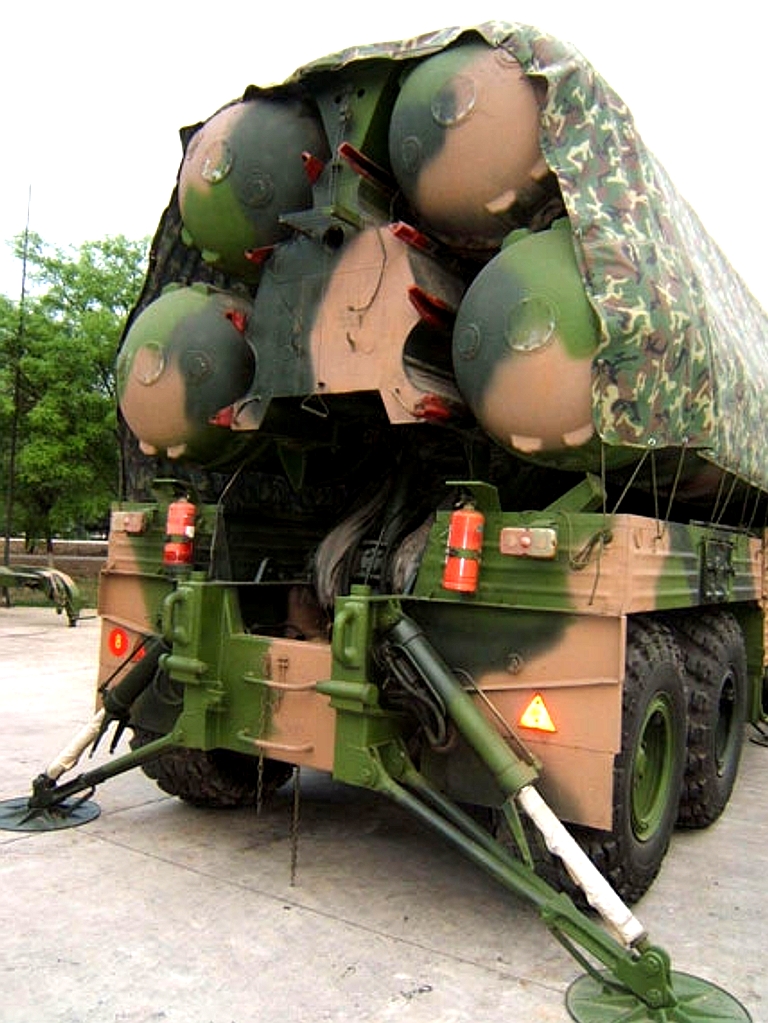
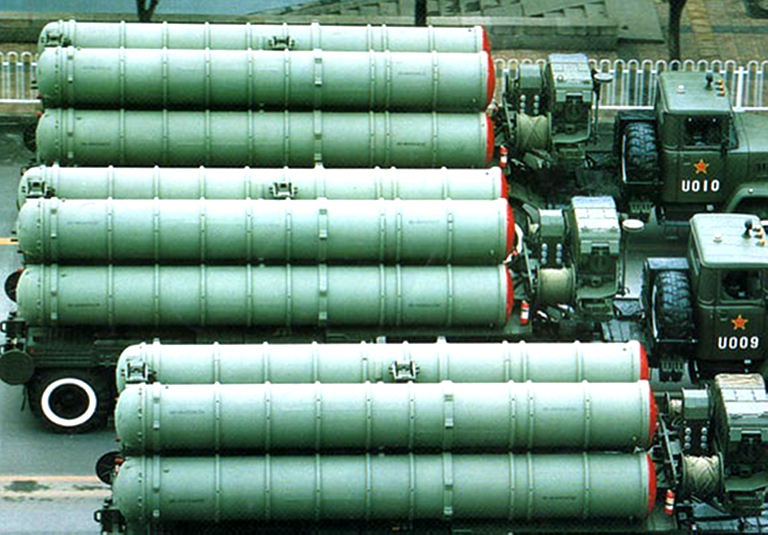
While the S-300PMU-1 retained improved Flap Lid, Clam Shell, and 5P58TE/DE TELs, it introduced two major new improvements, intended to match or outperform the Patriot PAC-1 and PAC-2 configurations. The first was a new missile design, the 80 nautical mile range 48N6, with a seeker capable of engaging 0.02 square metre targets.
Until recently the S-300PMU-1 was the most lethal SAM system the PLA deployed, but it has been now supplemented with the more effective S-300PMU-2.
Design of the S-300P and S-300V SAM Systems [Click for more ...]
Almaz S-300PMU / SA-10B(C) Grumble
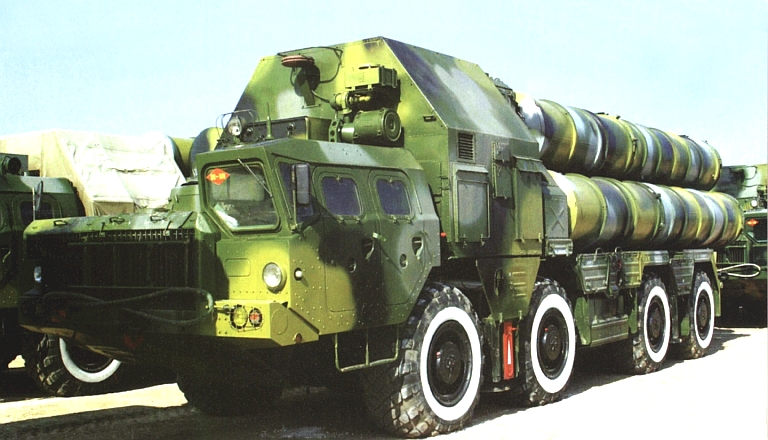
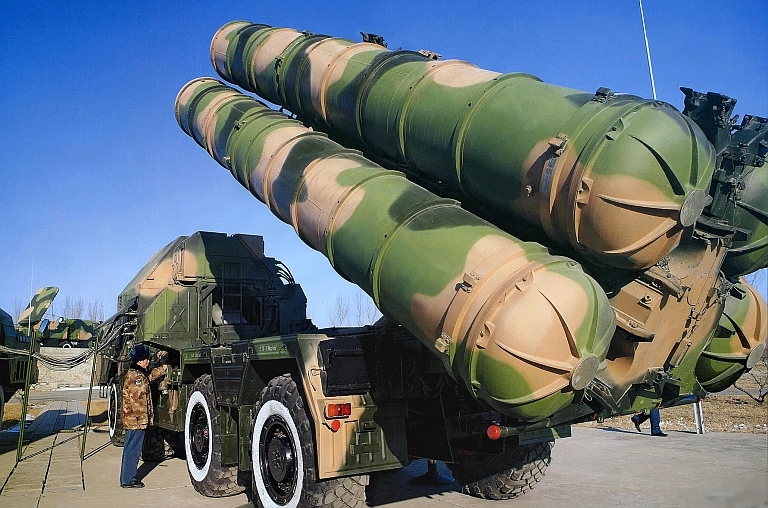
The S-300PMU was the first of the S-300 family of missiles to be procured by the PLA, and the US DoD puts current launcher numbers at 32, making for 4 to 8 deployable missile batteries. This system is the export configuration of the high mobility Soviet S-300PM (P- PVO, M - Modified) system, a deep upgrade based on the self-propelled S-300PS / SA-10B Grumble, itself successor to the Patriot-like semi-mobile S-300PT. This subtype is designated as an SA-10C in the literature.
The S-300PMU best compares to earlier variants of the US Patriot system, but with the important difference that the S-300PMU is highly mobile, with all key battery elements carried on MAZ-7900/543 variant 8x8 vehicles, common to the Scud TEL. The S-300PS/PM/PMU was the first true “shoot and scoot” SAM system to be deployed, specifically built to evade the F-4G Wild Weasel. When the export variant was defined, a towed semitrailer TEL was introduced, the 5P85T with a KrAZ-260B tractor, self-contained electrical power supply and masted radio datalink for remote launch control of TELs. Excluding mast mounted components, the battery could deploy or stow itself in 5 minutes or less.
The command link guided missiles in the S-300PT were supplanted by TVM guided extended 50 nautical mile range 5V55KD and 5V55R rounds. With all altitude coverage the S-300PS/PMU was a formidable system, capable of threatening the full gamut of conventional combat aircraft, and providing the impetus for the development of the F-117A and B-2A stealth aircraft.
Design of the S-300P and S-300V SAM Systems [Click for more ...]
Endnotes/References
[1] Excerpted from “How the PLA Fights: Weapons and Tactics of the People’s Liberation Army” published by the United States Army’s Training and Doctrine Command. Additions and updates by Dr Carlo Kopp.
[2] ‘Shui wan changgong fa tienlang ___ Zhongguo yanzhi WXZ204 ludai shi hog qi er haoyi dikong
[3] Andrei Chang, Analysis: China exports new SAM missile, United Press International, 18th March, 2009, URL: http://www.spacedaily.com/reports/Analysis_China_exports_new_SAM_missile_999.html
Imagery Sources: Chinese Internet.
Line Artwork: © 2000, 2007, 2008, 2009 Carlo Kopp

Technical Report APA-TR-2009-0103
|
|||||||||||||
![Sukhoi PAK-FA and Flanker Index Page [Click for more ...]](APA/flanker.png) |
![F-35 Joint Strike Fighter Index Page [Click for more ...]](APA/jsf.png) |
![Weapons Technology Index Page [Click for more ...]](APA/weps.png) |
![News and Media Related Material Index Page [Click for more ...]](APA/media.png) |
||||||||||
![Surface to Air Missile Systems / Integrated Air Defence Systems Index Page [Click for more ...]](APA/sams-iads.png) |
![Ballistic Missiles and Missile Defence Page [Click for more ...]](APA/msls-bmd.png) |
![Air Power and National Military Strategy Index Page [Click for more ...]](APA/strategy.png) |
![Military Aviation Historical Topics Index Page [Click for more ...]](APA/history.png)
|
![Information Warfare / Operations and Electronic Warfare Index Page [Click for more ...]](APA/iw.png) |
![Systems and Basic Technology Index Page [Click for more ...]](APA/technology.png) |
![Related Links Index Page [Click for more ...]](APA/links.png) |
|||||||
![Homepage of Australia's First Online Journal Covering Air Power Issues (ISSN 1832-2433) [Click for more ...]](APA/apa-analyses.png) |
|||||||||||||
| Artwork, graphic design, layout and text © 2004 - 2014 Carlo Kopp; Text © 2004 - 2014 Peter Goon; All rights reserved. Recommended browsers. Contact webmaster. Site navigation hints. Current hot topics. | |||||||||||||
|
Site Update
Status:
$Revision: 1.753 $
Site History: Notices
and
Updates / NLA Pandora Archive
|
|||||||||||||
|
|
Tweet | Follow @APA_Updates | |||||||||||
|
|
|||||||||||||
|
|
|||||||||||||
![F-111 Aardvark Index Page [Click for more ...]](APA/f-111.png)
![F/A-18 Hornet and Super Hornet Index Page [Click for more ...]](APA/fa-18a.png)
![Aerial Refuelling and Airlift Capabilities Index Page [Click for more ...]](APA/aar-lift.png)
![Directed Energy Weapons and Electromagnetic Bombs Index Page [Click for more ...]](APA/dew.png)
![Notices and Updates Index Page [Click for more ...]](APA/notices-128.png)
![APA NOTAM and Media Release Index Page [Click for more ...]](APA/notams-128.png)
![APA Research Activities and Policy / Technical Reports Index [Click for more ...]](APA/research-128.png)
![Search Air Power Australia Website [Click for more ...]](APA/search-128.png)
![Briefings and Submissions - Air Power Australia [Click for more ...]](APA/briefs-128.png)
![Air Power Australia Contacts [Click for more ...]](APA/contacts-128.png)
![Funding Air Power Australia [Click for more ...]](APA/funding-258.png)
